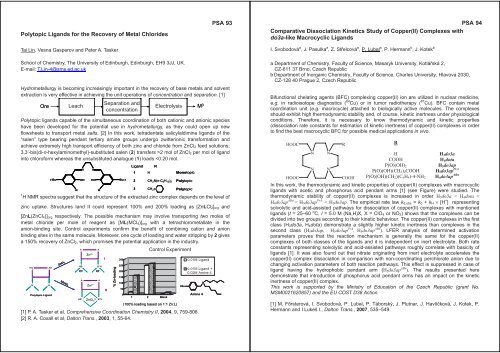Application of a new classes podands in solid-liquid phase transfer catalysis Bogusawa ska, Radosaw Pankiewicz and Grzegorz Schroeder Faculty of Chemistry, Adam Mickiewicz University, Grunwaldzka 6, 60-780 Pozna, Poland Phase transfer catalysis (PTC) is now a well established method in organic synthesis applicable to reactions of inorganic and organic anions and other active species with organic compounds. Phase transfer catalysis is a general technique widely used in organic chemistry, which usually, but not always, based on the reactions involving transfer of anion from an aqueous or solid phase into an organic phase followed by the reaction of anion with the substrate in organic phase. Reacting anions are continuously introduced into non-polar organic phase as ion pairs with complexed cations supplied by the catalyst. Further reactions of these ion pairs proceed in the organic phase. Nowadays the term “phase transfer catalysis” refers to several effective techniques whose typical advantages are simplicity, mild con<strong>di</strong>tions, high reaction rates and rather inexpensive reagents. It is also one of the most versatile preparative methods. The search for new catalysts, their use in PTC asymmetric synthesis and the attempts to understand their mechanistic role are exciting topics of investigation. In this presentation we report a systematic study of boron polypodands 1-4 and podands 2-8 synthesized on the base of Triton-X with B, Si and P as central atoms in the molecule, obtained in high yield by the reaction presented in Scheme 1. We used podands as catalysts in some phase transfer catalysis processes and they have been found excellent catalysts in some anion promoted reactions (nucleophilic substitution, reduction, alkylation, ect.) under solid-liquid con<strong>di</strong>tions in chlorobenzene as low polarity me<strong>di</strong>um and acetonitrile as polar aprotic solvent. A comparison is planned with the well known PTC catalysts: crown ethers DCH18C6 (9), PEG400Me2 (10) and Si-podand (11), stu<strong>di</strong>ed previously by us [1, 2]. B-podands O O B O Triton’s podands O CH3 2 O CH3 2 O CH3 2 O O B O O CH3 7 O CH3 7 O CH3 7 O O B 1 2 3 4 Tr = n = 10 Tr Tr Tr O O O O nO Si nO O n O CH3 12 O CH3 12 O CH3 12 O O Si O O O B O O B O O Tr n O Tr n O Tr n O O P O O Tr n O Tr n O Tr n O O Si O O Tr n O Tr n O Tr n 5 6 7 O O Tr n O Tr n O Tr n O CH3 16 [1] A. Maia, D. Lan<strong>di</strong>ni, B. ska and, G. Schroeder, Tetrahedron, 2004, 60, 10111-10115. [2] B. ska, R. Pankiewicz, G. Schroeder, A. Maia, Tetrahedron Lett., 2006, 47, 5673-5676. 8 O O CH 3 16 CH3 16 PSA 91 New DOTP analogue for possible me<strong>di</strong>cal applications Luís M. P. Lima a , Rita Delgado a,b , Petr Hermann c , Jan Kotek c a Instituto de Tecnologia Química e Biológica, UNL, Oeiras, Portugal b Instituto Superior Técnico, UTL, Lisboa, Portugal c Department of Inorganic Chemistry, Charles University, Prague, Czech Republic Cyclen derivatives with coor<strong>di</strong>nating pendant arms are suitable ligands for transition metal and lanthanide ions. In particular, lanthanide (III) complexes of ligands such as DOTA, DOTP and others have found important applications in the field of me<strong>di</strong>cinal chemistry, namely as contrast agents for Magnetic Resonance Imaging and as ra<strong>di</strong>opharmaceuticals for <strong>di</strong>agnosis or therapy. However, available data from the stu<strong>di</strong>es of such ligands are frequently obtained in <strong>di</strong>fferent experimental con<strong>di</strong>tions, which makes it <strong>di</strong>fficult to compare the properties of <strong>di</strong>fferent ligands. To overcome that problem we have recently stu<strong>di</strong>ed the solution behaviour of a series of macrocycles functionalized with acetic and methylphosphonic acid pendant arms [1]. The synthesis of macrocycles bearing mixed pendant arms is an important tool for developing ligands with improved chemical and biological properties or suitable for use as bifunctional chelators. During recent years we have focused on the synthesis and study of such macrocyclic derivatives [2]. (HO)2OP (HO)2OP N N N N R PO(OH)2 PSA 92 A new ligand analogue of DOTP was synthesized by introducing one pendant arm of a <strong>di</strong>fferent type on the DOTP structure. The protonation sites of the ligand were stu<strong>di</strong>ed by 31 P NMR titration. Protonation constants of the ligand as well as thermodynamic stability constants for some transition metal and lanthanide complexes were determined by potentiometric titrations. This ligand shows a very high overall basicity, and its metal complexes present also a very high stability. The <strong>di</strong>scussed properties are compared with those published for DOTP and other similar ligands. [1] R. Delgado, J. Costa, K. P. Guerra, and L. M. P. Lima, Pure Appl. Chem., 2005, 77, 569- 579. [2] V. Kubiek, J. Rudovský, J. Kotek, P. Hermann, L. Vander Elst, R. N. Muller, Z. I. Kolar, H. Th. Wolterbeek, J. A. Peters, and I. Lukeš, J. Am. Chem. Soc., 2005, 127, 16477-16485.
Polytopic Ligands for the Recovery of Metal Chlorides Tai Lin, Vesna Gasperov and Peter A. Tasker School of Chemistry, The University of E<strong>di</strong>nburgh, E<strong>di</strong>nburgh, EH9 3JJ, UK. E-mail: T.Lin-4@sms.ed.ac.uk Hydrometallurgy is becoming increasingly important in the recovery of base metals and solvent extraction is very effective in achieving the unit operations of concentration and separation. [1] Separation and Ore M concentration 0 Separation and Ore Leach Electrolysis M concentration 0 Leach Electrolysis Polytopic ligands capable of the simultaneous coor<strong>di</strong>nation of both cationic and anionic species have been developed for the potential use in hydrometallurgy, as they could open up new flowsheets to transport metal salts. [2] In this work, tetradentate salicylal<strong>di</strong>mine ligands of the “salen” type bearing pendant tertiary amine groups undergo zwitterionic transformation and achieve extremely high transport efficiency of both zinc and chloride from ZnCl2 feed solutions; 3,3’-bis(<strong>di</strong>-n-hexylaminomethyl)-substituted salen (2) transfers >2 mol of ZnCl2 per mol of ligand into chloroform whereas the unsubstituted analogue (1) loads

















